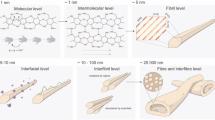Abstract
The networks of cellulose acetate and hydroxypropylcellulose prepared in the first part of this investigation were studied with regard to their mechanical properties. The quantities of particular interest were increases in tensile modulus and tensile strength obtained by drying the swollen films under strain, both uniaxial and equi-biaxial. These increases or improvements in mechanical properties were determined as a function of polymer concentration during cross-linking, polymer molecular weight, degree of cross-linking, and elongation during drying. In all cases, the improvements increased with increase in elongation during drying, and the largest increases were obtained in the case of the highest molecular weight polymer which had been lightly cross-linked in dilute (isotropic) solutions. The extent of ordering in these systems was gauged approximately by measurements of birefringence, which were correlated with their tensile moduli and tensile strengths.
Similar content being viewed by others
References
Yang Y, Mark JE, Kloczkowski A, Erman B, Bahar I, (1994) Colloid Polym Sci 272:284–292
Erman B, Bahar I, Kloczkowski A, Mark JE (1991) Macromolecules 23:5335
Bahar I, Erman B, Kloczkowski A, Mark JE (1991) Macromolecules 23:5341
Erman B, Bahar I, Kloczkowski A, Mark JE (1992) in: Mark JE, Erman B (eds) Elastomeric polymer networks, Prentice Hall, Englewood Cliffs, New Jersey
Erman B, Haliloglu T, Bahar I, Mark JE (1991) Macromolecules 24:901
Erman B, Bahar I, Yang Y, Kloczkowski A, Mark JE (1992) in: Noda I, Rubingh DN (eds) Polymer solutions, blends, and interfaces. Elsevier Sci. Pub., Amsterdam
Kloczkowski A, Mark JE, Erman B, Bahar I (1992) in: Noda I, Rubingh DN (eds) Polymer solutions blends, and interfaces. Elsevier Sci. Pub., Amsterdam
Erman B, Bahar I, Kloczkowski A, Mark JE (1992) in: Aharoni SM (ed) Synthesis, characterization, and theory of polymeric networks and gels. Plenum, New York
Flory PJ (1953) Principles of polymer chemistry. Cornell Univ. Press. Ithaca, New York
Yang Y (1993) Ph.D. Thesis in Chemistry, The University of Cincinnati
Barton AFM (1991) Handbook of solubility parameters and other cohesion parameters. 2nd Ed. CRC Press, Boca Raton, Florida
Hay IL (1980) in: Fava RA (ed) Methods of experimental physics. Vol 2, Pt C, Academic Press, New York
Mark JE, Erman B (1988) Rubberlike elasticity. A molecular primer. Wiley-Interscience, New York
Author information
Authors and Affiliations
Rights and permissions
About this article
Cite this article
Mark, J.E., Yang, Y., Kloczkowski, A. et al. A novel orientation technique for semi-rigid polymers. 2. Mechanical properties of cellulose acetate and hydroxypropylcellulose films. Colloid Polym Sci 272, 393–399 (1994). https://doi.org/10.1007/BF00659450
Received:
Accepted:
Issue Date:
DOI: https://doi.org/10.1007/BF00659450




